levy of tax under vat 9b an stamp duty simultaneously[1] - RS Goyal ...
levy of tax under vat 9b an stamp duty simultaneously[1] - RS Goyal ...
levy of tax under vat 9b an stamp duty simultaneously[1] - RS Goyal ...
Create successful ePaper yourself
Turn your PDF publications into a flip-book with our unique Google optimized e-Paper software.
Sumit NemaAdvocateMadhya Pradesh High Courtemail: advocatenema@gmail.comPhone: (0761)2404937Cell: 9713163667Fax No. (0761) 2403036Office & Residence(Jabalpur)‘Asha’,1029, Gol Bazar,JABALPUR (M.P) 482002Indore Br<strong>an</strong>ch Office303, Princess Valley,Next to Hotel PrincesPalace,South Tukog<strong>an</strong>j,INDORE – 452001ADDITIONAL POINT IN RELATION TO SECTION 9B OF VATACT 2002 AS INTRODUCED W.E.F.1-4-2011Under the Constitution, List II <strong>of</strong> the Seventh Schedule provides byEntry 49 the power to <strong>levy</strong> <strong>tax</strong> on l<strong>an</strong>d <strong>an</strong>d buildings. Under Entry64 <strong>of</strong> List II, the State has the power to prescribe the <strong>stamp</strong> <strong>duty</strong>.1. C<strong>an</strong> the State Government <strong>levy</strong> <strong>tax</strong> on building <strong>under</strong> Entry 49<strong>an</strong>d <strong>stamp</strong> <strong>duty</strong> on building <strong>under</strong> Entry 63 simult<strong>an</strong>eously ?Introductory Note :-The power to legislate is engrafted <strong>under</strong> Article 246 <strong>of</strong> theConstitution <strong>of</strong> India <strong>an</strong>d the various entries for the three lists <strong>of</strong>the Seventh Schedule are the “fields <strong>of</strong> legislation”. The differententries are all <strong>of</strong> enabling character <strong>an</strong>d are designed to define <strong>an</strong>ddelimit the respective areas <strong>of</strong> legislative competence <strong>of</strong> the Union<strong>an</strong>d the State legislatures. It has been a cardinal principle <strong>of</strong>construction that widest interpretation has to be given to theentries subject to the conditions that the me<strong>an</strong>ing <strong>of</strong> the wordsshould not be extended beyond their reasonable connotation <strong>an</strong>d
Actual Legal Position – Legality <strong>of</strong> the simult<strong>an</strong>eous imposition <strong>of</strong><strong>tax</strong> on ‘l<strong>an</strong>d <strong>an</strong>d buildings’ <strong>under</strong> Entry 49 <strong>of</strong> List II <strong>of</strong> ScheduleVII to the Constitution <strong>an</strong>d imposition <strong>of</strong> <strong>stamp</strong> <strong>duty</strong> on ‘l<strong>an</strong>d <strong>an</strong>dbuildings’ by the State Legislature in exercise <strong>of</strong> power <strong>under</strong>Entry 63 <strong>of</strong> List II :-Read with Article 246 <strong>of</strong> the Constitution <strong>of</strong> India, the StateLegislature c<strong>an</strong> <strong>levy</strong> <strong>stamp</strong> <strong>duty</strong> <strong>under</strong> Entry 44 <strong>of</strong> List III <strong>of</strong> theSeventh Schedule to the Constitution <strong>an</strong>d prescribes the rates <strong>of</strong><strong>stamp</strong> <strong>duty</strong> <strong>under</strong> Entry 63 <strong>of</strong> List II <strong>of</strong> the Seventh Schedule. Thepower to <strong>levy</strong> <strong>stamp</strong> <strong>duty</strong> is concurrent <strong>under</strong> Entry 63 <strong>of</strong> List II<strong>an</strong>d the power to prescribe the rates <strong>of</strong> <strong>stamp</strong> <strong>duty</strong> between theexclusive jurisdiction <strong>of</strong> the Union <strong>an</strong>d the State (a) as regards theinstruments specified in Entry 91 <strong>of</strong> List I, the power exclusivelybelongs to the Parliament, <strong>an</strong>d (b) regarding other instruments, thepower belongs to the States <strong>under</strong> Entry 63, List II. Entry 44 <strong>of</strong>List III <strong>of</strong> the Seventh Schedule relates to the <strong>stamp</strong> duties otherth<strong>an</strong> duties or fees collected by me<strong>an</strong>s <strong>of</strong> judicial <strong>stamp</strong>s, but notincluding rates <strong>of</strong> <strong>stamp</strong> <strong>duty</strong>. The charging provisions <strong>levy</strong>ing<strong>stamp</strong> <strong>duty</strong> could be enacted by both the Parliament <strong>an</strong>d the StateLegislatures, subject to the provisions <strong>of</strong> Article 254 <strong>of</strong> theConstitution.Entry 63 <strong>of</strong> List II <strong>of</strong> the Seventh Schedule to the Constitutionclearly states the power <strong>of</strong> the State Legislatures to prescribe therates <strong>of</strong> <strong>stamp</strong> <strong>duty</strong> in respect <strong>of</strong> documents other th<strong>an</strong> thosespecified in the provisions <strong>of</strong> List I with regard to rates <strong>of</strong> <strong>stamp</strong><strong>duty</strong>. The actual legal position is that once it is held that thepower to <strong>tax</strong> is within the competence <strong>of</strong> the State Legislature, noquestion <strong>of</strong> repugn<strong>an</strong>cy <strong>under</strong> Article 254 <strong>of</strong> the Constitution c<strong>an</strong>arise <strong>an</strong>d thus, where the <strong>levy</strong> <strong>of</strong> the <strong>stamp</strong> <strong>duty</strong> by the State isnot covered by <strong>an</strong>y <strong>of</strong> the entries in List I <strong>of</strong> the Seventh
Schedule <strong>an</strong>d is purely a <strong>tax</strong>ation measure <strong>an</strong>d the imposition <strong>of</strong>the <strong>duty</strong> or <strong>levy</strong> falls in the pith <strong>an</strong>d subst<strong>an</strong>ce <strong>of</strong> List II <strong>of</strong> theSeventh Schedule to the Constitution, it c<strong>an</strong>not be said that theState is incompetent to <strong>levy</strong> the <strong>stamp</strong> <strong>duty</strong> <strong>under</strong> Entry 44 <strong>of</strong>List III <strong>an</strong>d prescribe the rate <strong>of</strong> <strong>stamp</strong> <strong>duty</strong> <strong>under</strong> Entry 63 <strong>of</strong>List II <strong>of</strong> the Seventh Schedule to the Constitution [Bar Council<strong>of</strong> U.P. v. State <strong>of</strong> U.P., AIR 1973 SC 231 : (1973) 1 SCC 261].Furthermore, <strong>under</strong> Entry 44 <strong>of</strong> List III – the Concurrent List <strong>of</strong>Schedule VII, <strong>an</strong>y State Government as well as the CentralGovernment c<strong>an</strong> <strong>levy</strong> <strong>stamp</strong> duties other th<strong>an</strong> duties or feescollected by me<strong>an</strong>s <strong>of</strong> judicial <strong>stamp</strong>s, but not including rates <strong>of</strong><strong>stamp</strong> <strong>duty</strong> <strong>an</strong>d in respect <strong>of</strong> such instruments mentioned in Entry91 <strong>of</strong> List I – the Union List <strong>of</strong> the Seventh Schedule [that is, rates<strong>of</strong> <strong>stamp</strong> <strong>duty</strong> in respect <strong>of</strong> bills <strong>of</strong> exch<strong>an</strong>ge, cheques, promissorynotes, bills <strong>of</strong> lading, letters <strong>of</strong> credit, policies <strong>of</strong> insur<strong>an</strong>ce, tr<strong>an</strong>sfer<strong>of</strong> shares, debentures, proxies <strong>an</strong>d receipts] <strong>an</strong>d thus, the rates <strong>of</strong><strong>stamp</strong> <strong>duty</strong> c<strong>an</strong> be prescribed by the Parliament only with regardto instruments falling within Entry 91 <strong>of</strong> List I <strong>an</strong>d with regard toother instruments, by the State Legislatures <strong>under</strong> Entry 63 <strong>of</strong> ListII [Veena Hasmukh Jain v. State <strong>of</strong> Maharashtra, AIR 1999 SC807 : (1999) 5 SCC 725]. There is also no dispute that there islegislative competence in the State Government to <strong>levy</strong> <strong>stamp</strong> <strong>duty</strong>on a convey<strong>an</strong>ce <strong>of</strong> property [H<strong>an</strong>um<strong>an</strong> Vitamin Foods (P) Ltd. v.State <strong>of</strong> Maharashtra, AIR 2000 SC 2571 : (2000) 6 SCC 345].The entries in the three lists <strong>of</strong> the Seventh Schedule to the Constitutionare legislative heads <strong>an</strong>d are <strong>of</strong> enabling character <strong>an</strong>d each general wordshould be interpreted to extend to all <strong>an</strong>cillary or subsidiary matterswhich c<strong>an</strong> fairly <strong>an</strong>d reasonably be comprehended in it. The powers <strong>of</strong>the Union <strong>an</strong>d the State Legislatures are both expressed in precise <strong>an</strong>d indefinite terms <strong>an</strong>d, therefore, there c<strong>an</strong> be no reason in giving broader
interpretation to one rather th<strong>an</strong> to the other. It is true that whilelegislating on <strong>an</strong>y subject covered <strong>under</strong> <strong>an</strong> entry <strong>of</strong> <strong>an</strong>y list, there c<strong>an</strong>always be a possibility <strong>of</strong> entrenching upon or touching the field <strong>of</strong>legislation <strong>of</strong> <strong>an</strong>other entry <strong>of</strong> the same list or <strong>an</strong>other list for matterswhich may be incidental or <strong>an</strong>cillary thereto. In such eventuality, a broad<strong>an</strong>d liberal interpretation <strong>of</strong> <strong>an</strong> entry in the list may certainly be required.It may not be reasonable to import <strong>an</strong>y limitation in interpreting aparticular entry in the List by comparing the said entry orcontrasting it with <strong>an</strong>y other entry in that very List. While thecourt is determining the scope <strong>of</strong> the area covered by a particularentry, the court must interpret the relev<strong>an</strong>t words in the entry in <strong>an</strong>atural way <strong>an</strong>d give the said words the widest interpretation. Whatthe entries purport to do is to describe the area <strong>of</strong> legislativecompetence <strong>of</strong> the different legislative bodies, <strong>an</strong>d, therefore, itwould be unreasonable to approach the task <strong>of</strong> interpretation in <strong>an</strong>arrow or restrictive m<strong>an</strong>ner [B<strong>an</strong>arasi Dass v. WTO, AIR 1965SC 1387].An absolute or watertight compartmentalization <strong>of</strong> the heads <strong>of</strong> subjectfor legislation may not be possible but at the same time, entrenching intothe field <strong>of</strong> <strong>an</strong>ther entry c<strong>an</strong>not me<strong>an</strong> its total sweeping <strong>of</strong>f even thoughit may be in the executive list <strong>of</strong> heads <strong>of</strong> subjects for legislation by theother legislature. It is only when <strong>an</strong> apparent overlapping occurs that thedoctrine <strong>of</strong> “pith <strong>an</strong>d subst<strong>an</strong>ce” has to be applied to find out the truenature <strong>of</strong> legislation <strong>an</strong>d the entry within which it would fall. Whendifferent entries in the same list crop up for consideration, the usualprinciple followed is that each particular entry should relate to a separatesubject or group <strong>of</strong> subjects <strong>an</strong>d every attempt should be made toharmonize different entries <strong>an</strong>d to discard a construction which willrender <strong>an</strong>y <strong>of</strong> the entries ineffective [ITC Ltd. v. Agricultural ProduceMarket Committee, AIR 2002 SC 852 : (2002) 9 SCC 232].
Further, in Hindust<strong>an</strong> Lever v. State <strong>of</strong> Maharashtra, AIR 2004 SC326 : (2004) 9 SCC 438, where the State legislation, that is, theBombay Stamp Act, 1958, sought to impose <strong>stamp</strong> <strong>duty</strong> on <strong>an</strong>order s<strong>an</strong>ctioning the scheme <strong>of</strong> amalgamation <strong>of</strong> two comp<strong>an</strong>iespassed by the court <strong>under</strong> Section 394 read with Section 391 <strong>of</strong>the Comp<strong>an</strong>ies Act, 1956, it was held to be valid being <strong>an</strong>instrument effecting tr<strong>an</strong>sfer <strong>of</strong> assets <strong>an</strong>d liabilities between theparties. It was also observed that <strong>stamp</strong> <strong>duty</strong> is levied on theinstrument <strong>an</strong>d the measure is the valuation <strong>of</strong> the propertytr<strong>an</strong>sferred. There is no question <strong>of</strong> encroachment on the field <strong>of</strong>the Parliament <strong>under</strong> Entry 43 <strong>of</strong> List I <strong>of</strong> the Seventh Scheduleto the Constitution since the follow-up legislation <strong>under</strong> Entry 43<strong>of</strong> List I pertaining to incorporation, regulation <strong>an</strong>d winding up <strong>of</strong>trading corporations, including b<strong>an</strong>king, insur<strong>an</strong>ce <strong>an</strong>d fin<strong>an</strong>cialcorporations but not including co-operative societies is totallydifferent from the <strong>levy</strong> <strong>of</strong> <strong>stamp</strong> <strong>duty</strong> <strong>an</strong>d <strong>of</strong> prescribing the rate<strong>of</strong> <strong>stamp</strong> <strong>duty</strong> <strong>under</strong> the State legislation in respect <strong>of</strong> documentspertaining to compromise or arr<strong>an</strong>gement <strong>of</strong> such corporations. TheState legislation does not, in <strong>an</strong>y way, describe <strong>an</strong>y alternateprocedure as compared to the one appearing in Section 394 <strong>of</strong> theComp<strong>an</strong>ies Act, 1956 <strong>an</strong>d, therefore, the question <strong>of</strong> repugn<strong>an</strong>cy isirrelev<strong>an</strong>t. Entry 63 <strong>of</strong> List II empowers the State Legislature toprescribe the rates <strong>of</strong> <strong>stamp</strong> <strong>duty</strong> in respect <strong>of</strong> documents otherth<strong>an</strong> those specified in the provisions <strong>of</strong> List I, that is, rates <strong>of</strong><strong>stamp</strong> <strong>duty</strong> in respect <strong>of</strong> bills <strong>of</strong> exch<strong>an</strong>ge, cheques, promissorynotes, bills <strong>of</strong> lading, letters <strong>of</strong> credit, policies <strong>of</strong> insur<strong>an</strong>ce, tr<strong>an</strong>sfer<strong>of</strong> shares, debentures, proxies <strong>an</strong>d receipts. By s<strong>an</strong>ctioning <strong>of</strong> theamalgamation scheme, the property including the liabilities aretr<strong>an</strong>sferred as provided in Section 394 <strong>of</strong> the Comp<strong>an</strong>ies Act <strong>an</strong>don that tr<strong>an</strong>sfer instrument, <strong>stamp</strong> <strong>duty</strong> is levied. It, therefore, c<strong>an</strong>notbe said that the State Legislature has no jurisdiction to <strong>levy</strong> such<strong>duty</strong>.
Taking the aforementioned view into consideration, it is to be<strong>under</strong>stood that Entry 49 <strong>of</strong> List II basically pertains to <strong>tax</strong> onl<strong>an</strong>d <strong>an</strong>d buildings while Entry 63 <strong>of</strong> List II deals with imposition<strong>of</strong> <strong>stamp</strong> <strong>duty</strong> which, though may be imposition <strong>of</strong> <strong>stamp</strong> <strong>duty</strong> onl<strong>an</strong>d <strong>an</strong>d buildings, is a different subject <strong>an</strong>d, on a harmoniousconstruction, neither <strong>of</strong> these separate subjects or different entries,though pertaining to allied matters, c<strong>an</strong> be rendered otiose orme<strong>an</strong>ingless.Basis <strong>of</strong> challenge to the legality <strong>of</strong> the simult<strong>an</strong>eous imposition <strong>of</strong><strong>tax</strong> on ‘l<strong>an</strong>d <strong>an</strong>d buildings’ <strong>under</strong> Entry 49 <strong>of</strong> List II <strong>an</strong>d <strong>stamp</strong><strong>duty</strong> on ‘l<strong>an</strong>d <strong>an</strong>d buildings’ <strong>under</strong> Entry 63 <strong>of</strong> List II <strong>of</strong>Schedule VII to the Constitution by the State Legislature :-In the case <strong>of</strong> challenge to the vires or legality <strong>of</strong> the power <strong>of</strong> theState Legislature to simult<strong>an</strong>eously <strong>levy</strong> <strong>tax</strong> on l<strong>an</strong>d <strong>an</strong>d buildingsin exercise <strong>of</strong> power <strong>under</strong> Entry 49 <strong>of</strong> List II <strong>of</strong> Schedule VII tothe Constitution as well as prescribe the <strong>stamp</strong> <strong>duty</strong> <strong>under</strong> Entry63 <strong>of</strong> List II, such challenge may be supported on the foundationthat the word “<strong>tax</strong>”, when interpreted in its widest sense, includesall money raised by <strong>tax</strong>ation <strong>an</strong>d it, therefore, includes <strong>tax</strong>es leviedby the Central <strong>an</strong>d the State Legislatures, <strong>an</strong>d also those known as“rates”, or other charges levied by local authorities <strong>under</strong> statutorypowers. “Taxation”, therefore, includes the imposition <strong>of</strong> <strong>an</strong>y <strong>tax</strong> orimpost, whether general or local or special, <strong>an</strong>d “<strong>tax</strong>” should beconstrued accordingly [D.G. Gose <strong>an</strong>d Co. (Agents) (P) Ltd. v. State<strong>of</strong> Kerala, AIR 1980 SC 271 : (1980) 2 SCC 410]. In view <strong>of</strong> suchinterpretation, the need to impose <strong>stamp</strong> <strong>duty</strong> or <strong>an</strong>y other impostseparately on l<strong>an</strong>d <strong>an</strong>d buildings apart from that in Entry 49 <strong>of</strong>List II does not arise.
Furthermore, it is also well settled that the mutual exclusivity <strong>of</strong><strong>tax</strong>es which has been reflected in Article 246 (1) me<strong>an</strong>s that the<strong>tax</strong>ing entries must be construed so as to maintain exclusivity <strong>an</strong>dalthough a <strong>tax</strong>ing entry should be given a liberal interpretation, yetthat c<strong>an</strong>not be deemed to cover a subject-matter which, on a fairreading <strong>of</strong> the entry, it does not cover [Gujarat Ambuja CementsLtd. v. Union <strong>of</strong> India, AIR 2005 SC 3020 : (2005) 4 SCC 214]. It isequally settled that each general word in <strong>an</strong> entry should be interpretedto extend to all <strong>an</strong>cillary or subsidiary matters which c<strong>an</strong> fairly <strong>an</strong>dreasonably be comprehended in it. Therefore, when the <strong>tax</strong> has alreadybeen sought to be levied by the State legislature on l<strong>an</strong>d <strong>an</strong>dbuildings, it includes all rates or <strong>tax</strong>es or imposts, whether generalor local or special, <strong>an</strong>d, hence, the State ought not to impose <strong>tax</strong> onl<strong>an</strong>d <strong>an</strong>d buildings in exercise <strong>of</strong> its power <strong>under</strong> Entry 49 <strong>of</strong> ListII as well as <strong>stamp</strong> <strong>duty</strong> <strong>under</strong> Entry 63 <strong>of</strong> List II simult<strong>an</strong>eouslyas that would amount to double <strong>tax</strong>ation <strong>of</strong> the same property.If it is open to resolve the conflict between two entries indifferent Lists by examining the domin<strong>an</strong>t purpose <strong>an</strong>d the pith<strong>an</strong>d subst<strong>an</strong>ce <strong>of</strong> the two legislations, there is no reason why therepugn<strong>an</strong>cy between the provisions <strong>of</strong> the two legislations <strong>under</strong>different entries in the same List should not be resolved byscrutinizing the same on the same touchstone. What is to beascertained in each case is whether the legislations are on thesame subject-matter or not by finding out the domin<strong>an</strong>t intentionor pith <strong>an</strong>d subst<strong>an</strong>ce <strong>of</strong> the two legislations. The cause <strong>of</strong> conflictarises when there is the apparent identity <strong>of</strong> the subject-matters<strong>an</strong>d one legislation covers the entire field covered by the other<strong>an</strong>d not merely partially in a different context <strong>an</strong>d further, both thelegislations are subst<strong>an</strong>tially on the same subject-matter [VijayKumar Sharma v. State <strong>of</strong> Karnataka, AIR 1990 SC 2072 : (1990)2 SCC 562]. In the inst<strong>an</strong>t case, Entry 49 <strong>of</strong> List II covers theentire subject <strong>of</strong> ‘l<strong>an</strong>d <strong>an</strong>d buildings’ while Entry 63 <strong>of</strong> List II
deals with the power <strong>of</strong> the State Legislatures to prescribe therates <strong>of</strong> <strong>stamp</strong> <strong>duty</strong> in respect <strong>of</strong> documents other th<strong>an</strong> thosespecified in the provisions <strong>of</strong> List I <strong>an</strong>d hence, if <strong>an</strong> extendedme<strong>an</strong>ing is given to Entry 63 <strong>of</strong> List II to cover ‘l<strong>an</strong>d <strong>an</strong>dbuildings’ which is already covered by Entry 49 <strong>of</strong> the same List,the same would result in conflict as both the entries would thensubst<strong>an</strong>tially cover the same subject matter.It is true that <strong>under</strong> the three lists <strong>of</strong> the Seventh Schedule to theConstitution, a <strong>tax</strong>ation entry in a legislative list may be withrespect to <strong>an</strong> object or <strong>an</strong> event or may be with respect to both<strong>an</strong>d Article 246 makes it clear that the exclusive powers conferredon the Parliament or the States to legislate on a particular matterincludes the power to legislate with respect to that matter. Hence,where the entry describes <strong>an</strong> object <strong>of</strong> <strong>tax</strong>, all <strong>tax</strong>able eventspertaining to the object are within that field <strong>of</strong> legislation unlessthe event is specifically provided for elsewhere <strong>under</strong> a differentlegislative head <strong>an</strong>d where articles have been made the object <strong>of</strong><strong>tax</strong>ation, either directly or indirectly, the entries in the legislativelists have specifically said so or the impost is such that thesubject-matter <strong>of</strong> <strong>tax</strong> follows by necessary implication. It is alsotrite that <strong>tax</strong>ing entries must be construed with clarity <strong>an</strong>dprecision so as to maintain the mutual exclusivity which isreflected in Article 246 <strong>an</strong>d a construction <strong>of</strong> a <strong>tax</strong>ation entrywhich may lead to overlapping must be eschewed. If the <strong>tax</strong>ingpower is within a particular legislative field, it would follow thatother fields in the legislative lists must be construed to excludethis field so that there is no possibility <strong>of</strong> legislative trespass[Godfrey Phillips India Ltd. v. State <strong>of</strong> U.P., (2005) 2 SCC 515].Thus, when the State Legislature has been conferred with thepower to impose <strong>tax</strong> on l<strong>an</strong>d <strong>an</strong>d buildings by virtue <strong>of</strong> a specificentry, that is, Entry 49 <strong>of</strong> List II <strong>of</strong> Schedule VII to theConstitution, the exclusivity <strong>of</strong> that <strong>tax</strong>ing entry ought to be
maintained <strong>an</strong>d all <strong>tax</strong>able events pertaining to the ‘l<strong>an</strong>d <strong>an</strong>dbuildings’ ought to be construed within that field <strong>of</strong> legislationsince the <strong>tax</strong>able event is nowhere else specifically provided for<strong>under</strong> a different legislative head.It is settled that each general word in <strong>an</strong> entry should be interpretedto extend to all <strong>an</strong>cillary or subsidiary matters which c<strong>an</strong> fairly <strong>an</strong>dreasonably be comprehended in it <strong>an</strong>d the entries in the legislativelists must be given a broad <strong>an</strong>d liberal me<strong>an</strong>ing. Where there is noquestion <strong>of</strong> conflict between two items in the same List, there isno warr<strong>an</strong>t for restricting the natural me<strong>an</strong>ing <strong>of</strong> one for thesimple reason that the same subject might in some aspect comewithin the purview <strong>of</strong> the other [State <strong>of</strong> Bombay v. NarottamdasJethabhai, AIR 1951 SC 69]. The aforementioned principle conveysthat in the situation <strong>of</strong> conflict between two entries in the sameList, there may be need for restricting the natural me<strong>an</strong>ing <strong>of</strong> onefor the simple reason that the same subject might not come withinthe purview <strong>of</strong> the other. Even according to Seervai [Seervai, H.M. :Constitutional Law <strong>of</strong> India, 4 th /Silver Jubilee Edn., Vol. 3, para22.20], although legislative power includes all incidental <strong>an</strong>dsubsidiary power, yet the power to impose a <strong>tax</strong> is not such apower <strong>under</strong> our Constitution. Thus, the power to <strong>tax</strong> is not <strong>an</strong>incidental power <strong>an</strong>d even the entry in respect <strong>of</strong> prescribing <strong>of</strong>the rates <strong>of</strong> <strong>stamp</strong> <strong>duty</strong>, that is, Entry 63 <strong>of</strong> List II, c<strong>an</strong>not begiven <strong>an</strong> extended interpretation or a far too liberal construction soas to cover the <strong>levy</strong> <strong>of</strong> <strong>an</strong>y kind <strong>of</strong> <strong>tax</strong> or other impost, <strong>duty</strong> orfee, on a subject matter – l<strong>an</strong>d <strong>an</strong>d buildings – which, on a fairreading <strong>of</strong> the entry, it does not cover <strong>an</strong>d which has been alreadycovered by <strong>an</strong>other specific entry <strong>of</strong> the same list.Furthermore, there is nothing like <strong>an</strong> implied power to <strong>tax</strong>. Thesource <strong>of</strong> power which does not specifically speak <strong>of</strong> <strong>tax</strong>ation
c<strong>an</strong>not be so interpreted by exp<strong>an</strong>ding its width as to includetherein the power to <strong>tax</strong> by implication or by necessary inference[State <strong>of</strong> W.B. v. Kesoram Industries Ltd., (2004) 10 SCC 201].Thus, where Entry 63 <strong>of</strong> List II <strong>of</strong> the Seventh Schedule to theConstitution does not expressly include the subject ‘l<strong>an</strong>d <strong>an</strong>dbuildings’ within its purview, the same c<strong>an</strong>not be so interpreted byexp<strong>an</strong>ding its width as to include therein the power to <strong>levy</strong> <strong>an</strong>ykind <strong>of</strong> <strong>tax</strong> or impost by implication or inference.SUMIT NEMAC.A.,LL.B


![levy of tax under vat 9b an stamp duty simultaneously[1] - RS Goyal ...](https://img.yumpu.com/45559052/1/500x640/levy-of-tax-under-vat-9b-an-stamp-duty-simultaneously1-rs-goyal-.jpg)
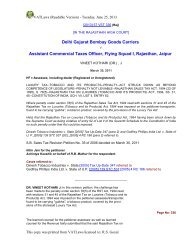
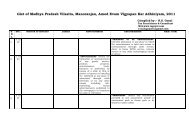

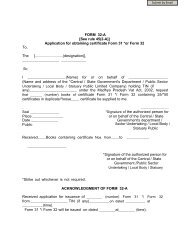
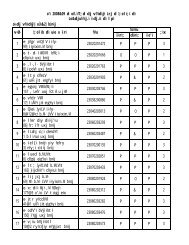
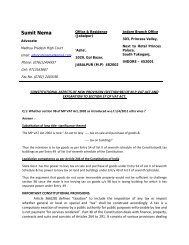
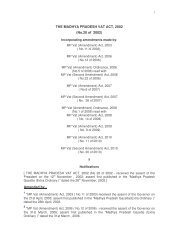


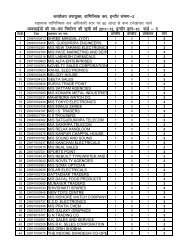
![[2012] 54 VST 26 (P and H) - RS Goyal & Associates](https://img.yumpu.com/38348208/1/190x245/2012-54-vst-26-p-and-h-rs-goyal-associates.jpg?quality=85)

![[2012] 47 vst 116 (cestat) - RS Goyal & Associates](https://img.yumpu.com/38348091/1/190x245/2012-47-vst-116-cestat-rs-goyal-associates.jpg?quality=85)
![[2012] 47 VST 379 (Ker) - RS Goyal & Associates](https://img.yumpu.com/38348087/1/190x245/2012-47-vst-379-ker-rs-goyal-associates.jpg?quality=85)